Lecture
For its more than a thousand-year history, the Russian state has passed a difficult development path, which was influenced by many external and internal factors. Having appeared at the junction of Europe and Asia, having absorbed the features of both the West and the East, Russia is a kind of Eurasian civilization. In order to assess the place of Russia in world development, it is necessary to trace the historical path that it has gone from its inception to the present.
The history of the largest Russian state in Europe has developed, on the one hand, like the history of other peoples and states, and on the other hand, has a number of features. Our ancestors were ancient Slavs. Until now, scientists have no consensus on the homeland of the ancestors of the Slavs, where did they come to the expanses of the East European Plain - the territory of the future Russian state, when it happened, when the ancient Slavic cities were formed, and what kind of economy of the ancient Slavs was like.
Various hypotheses of scientists have been developed and continue to be developed on the basis of various archaeological and linguistic sources, as well as written monuments.
On the history of Russia, many scientific works were written by foreign and Russian historians. Among our compatriots an outstanding place is occupied by outstanding historians N.M. Karamzin (1766-1826), S.M. Soloviev (1820-1879), V.O. Klyuchevsky (1841-1911), S.F. Platonov (1860-1933) and others. In Soviet times, famous scientists, such as the database, devoted their work to the history of Russia. Grekov (1882-1953), B.A. Rybakov (b. 1908), L.N. Gumiev (1912-1993) and others.
4.1. The oldest settlements in Ukraine, European Russia and Belarus (from the beginning to the VI century AD)
a) Greek colonies - policies (VII – VI centuries BC);
b) tribes of the Scythians (VIII-VII centuries. BC. e.);
c) the ethnic community of the Sarmatians (III century BC);
d) the Germanic tribes of the Goths (II — III centuries AD);
e) the invasion of the Huns in the Black Sea region (from the 70s of the 4th century);
f) the invasion of the Avars (VI century);
g) Khazar Khaganate (VII century - end of the X century).
The predecessors of the ancient Slavs. On the territory of Ukraine, European Russia and Belarus, primitive man appeared in the early Paleolithic period - the ancient Stone Age (about 700 thousand years ago). The settlement came from the south, as evidenced by archaeological finds. So, in the Yitomyr region and on the Dniester, traces of ancient people were found 500-300 thousand years ago. Places for people of the Middle Paleolithic (100-35 thousand years BC) were found on the territory of Russia: in the Middle and Lower Volga and in other places. These settlements were relatively small and were located at a considerable distance from each other.
During the late Paleolithic period (35-10 thousand years BC), a skilled person (homo habilis) was replaced by a rational person (homo sapiens), a primitive herd was replaced by the highest form of organization of society - a clan community.
A unique monument of the Late Paleolithic is the culture of Sungir (near Vladimir). Archaeological finds tell about the appearance, clothing, material culture and ritual ceremonies of that time.
Ancient people were engaged in the collection, hunting, fishing (appropriation of the farm), and later in agriculture and livestock (farm production). Hoe agriculture (manually with a hoe without coercive force) was later replaced by a plow - horses or oxen were pinned to the plow.
In the Bronze Age (III-II thousand years BC), specialization in the production of the economy began. In the North, hunting and fishing remain the main occupation; nomadic cattle breeding and agriculture prevail in the steppe belt.
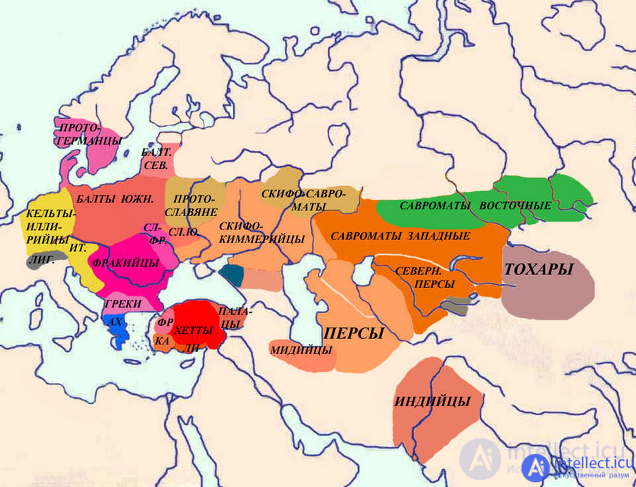
With the advent of the iron ax (I millennium BC), it became possible to clear forests for arable land, and agriculture moved further and further north.
The use of metal (copper, bronze, iron) tools increased the productivity of all types of human activity. Cattle stand out from hunting and agricultural tribes. This was the first major social division of labor.
The advent of metals, especially the use of iron, contributed to the development of crafts. The second major social division of labor occurred when the craft was separated from agriculture. This led to the production of surplus products, which went on the exchange not only within the tribe and on its borders, but also with more distant tribes. The process of differentiation of property has intensified.
Ancestors of the ancient Slavs
The predecessors of the ancient Slavs. . On the northern shore of the Black Sea, which the Greeks called Pont Euxine, in the VII-VI centuries. Bc. there were many Greek colonies - city-states (polis). The most famous of them are Olbia at the mouth of the Bug River, Chersonese (the old Russian name Korsun) in the vicinity of modern Sevastopol, Panticapaeum (on the site of present-day Kerch), Phanagoria on the Taman Peninsula, Tanais at the mouth of the Don River and others. The Greeks led the local population - Scythians - not only lively trade, but also had their own cultural influence on them. The Greeks bought mainly bread, fish and sold fabrics, wine, oil, luxury goods.

As a result of such ties, mixed Hellenic-Scythian settlements were created. With a center in Panticapaeum, Bosporan Kingdom 1 (V-IV centuries BC) arose, uniting some Greek cities, as well as local Scythian tribes.
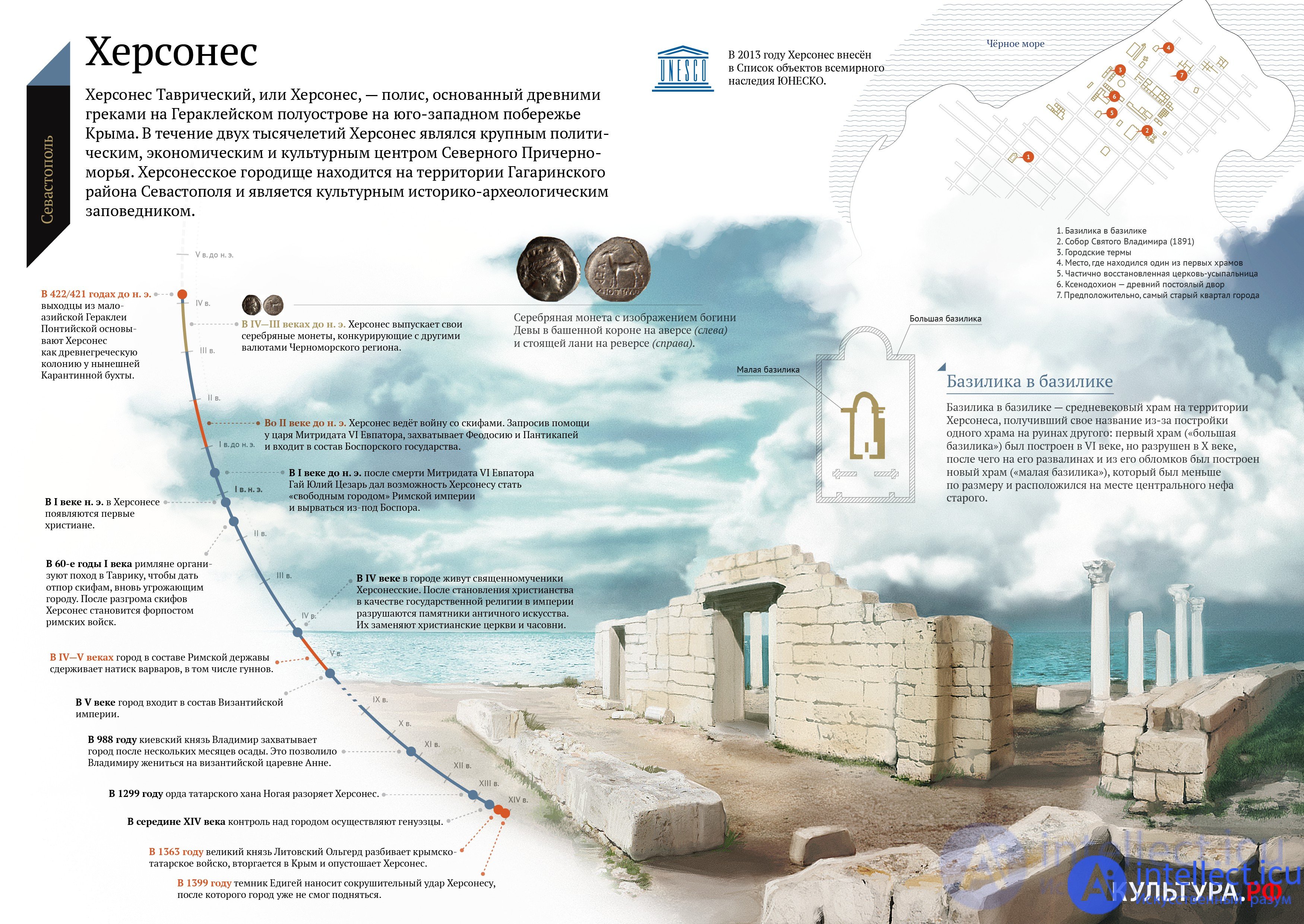
OLVIA (dr. Greek Óλβια - happy, rich) - Greek colony founded by immigrants from Miletus in the VI century. and destroyed by the Huns IV century. BC e.
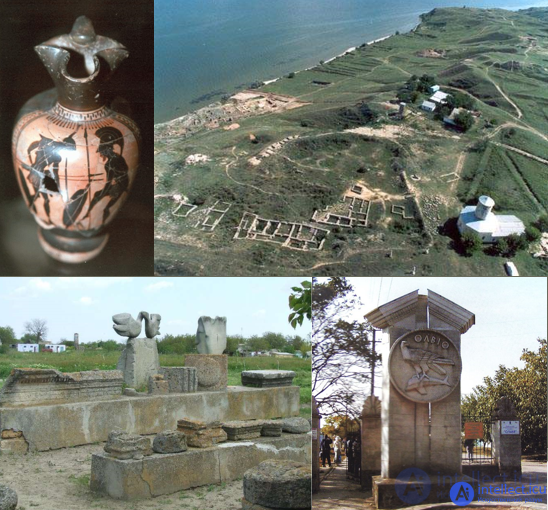
The Bosporus Kingdom of the 5th century BC. - IV century AD (capital of Panticapaeum), the union of 20 cities.
The rule of the dynasty of Persians and Mithridates. It is populated by mixed Hellenic-Scythian settlements.
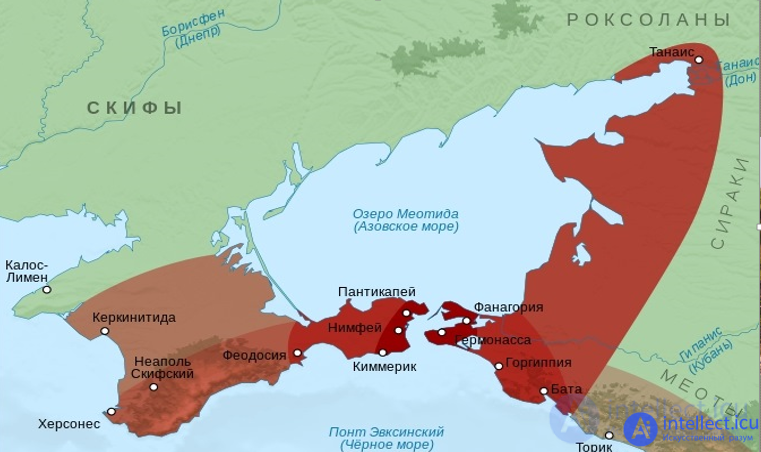
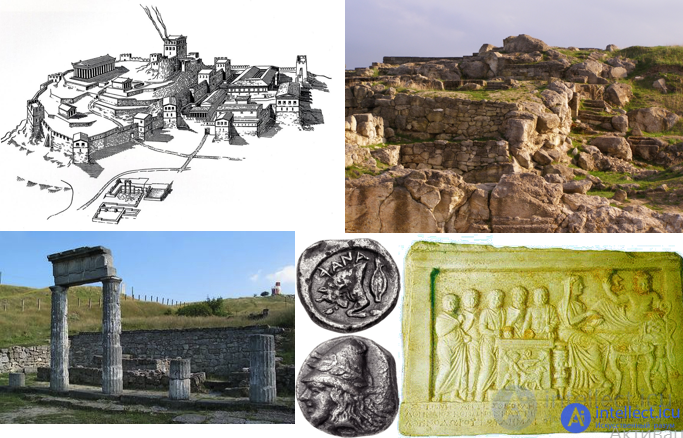
Homer wrote in the "Odyssey":
There is a city of the people of the Cimmerian men,
Forever covered in fog and clouds: bright sun
There will never flash either its rays or light ...
.
CIMMERIANS FIRST IN THE TERRITORY OF SOUTH UKRAINE:
became pastoralists and led a nomadic lifestyle;
mastered the art of riding, riders made military campaigns with the aim of robbery;
the tribes of the Srubnaya culture of the Late Bronze Age laid the foundation for the Iron Age;
a military aristocracy, tribal unions, and slave relations arose;
under the blows of the Scythians they left for Thrace, part assimilated.
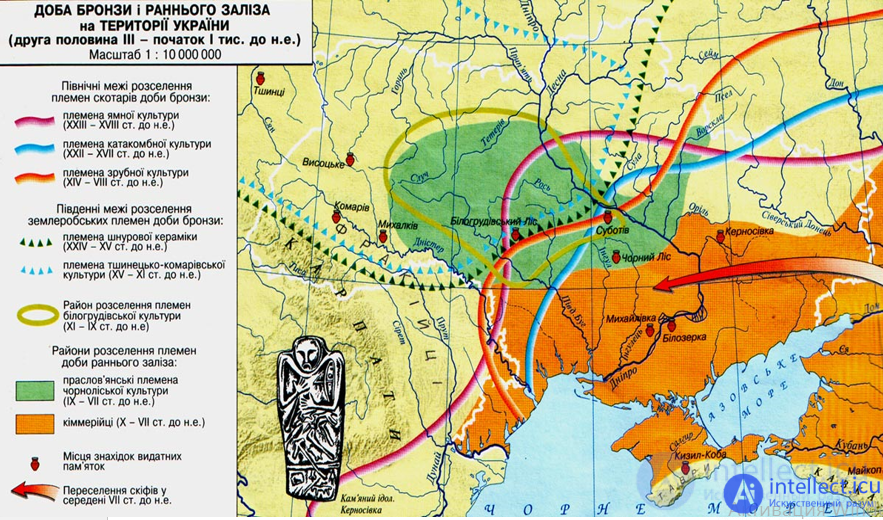
Scythian nomadic tribes in the VIII-VII centuries. BC.
Under the general name "Scythians" nomadic tribes are known, which differed in the place of settlement and occupation.
Scythian nomadic tribes arrived from Asia in the southern and southeastern steppes, crowding out the predominant ethnic community here, the agricultural people of the Cimmerians, who went far to Thrace. Under the general name "Scythians" 1 of them are numerous nomadic tribes that differed in the place of settlement and their occupation. The royal Scythians, who lived in the lower reaches of the Dnieper on the left bank, were considered the main tribe. Nomadic Scythians lived on the right bank of the Lower Dnieper; west of them, Scythian farmers and Scythian plowmen on the middle Dnieper.
The main occupation of the Scythians was animal husbandry and agriculture. The Scythian farmers traded grain with the cities of the Black Sea coast in Greece, from where the Greeks delivered grain to Hellas. According to the ancient Greek historian Herod A. a, they cultivated "the best wheat in the world." Scythians mastered crafts well: worked with iron and bronze, made weapons, made leather. This is evidenced by numerous archaeological finds in the Scythian mounds.
In the VI-IV centuries. BC. The Scythians united in a large tribal union, on the basis of which the Scythian kingdom was formed with the Scythian capital in Naples (near modern Simferopol). the state was an alliance of warlike tribes led by a king, and tribal leaders were led by troops during the campaigns. The king’s power was inherited. In the state, a gradual stratification of the population was observed, the military and priestly aristocracy were highlighted. The main work was carried out by free members of the community — shepherds and peasants; slave labor was insignificant.
Herodotus writes that in the second half of the fifth century. BC .. The Scythian kingdom occupied a huge space from the Don in the east to the mouths of the Danube and the Lower Dnieper in the west.

In III. BC .. Scythians are supplanted by a new ethnic community - the Sarmatians, who previously lived in the east of Scythia, beyond the Don. The borders of the Sarmatians, according to ancient writers, were more extensive: almost from the Carpathians, the Vistula, the Danube to the Don, Volga, and Urals.
Scythian tribes:
• royal Scythians lived in the lower reaches and along the left bank of the Dnieper;
• nomadic Scythians populated the right bank of the lower Dnieper;
• Scythian farmers and Scythian plowmen lived on the middle Dnieper.
Sources of enrichment of the Royal Scythians:
1. Tribute;
2. Military robbery;
3. Trade with the Greeks.
In the VII-V centuries. BC. on the basis of the union of warlike Scythian tribes the Scythian kingdom arose, the capital is the city of Naples Scythian (near Simferopol).
Herodotus wrote that in the V century. BC. the kingdom occupied the territory from the Don in the east to the mouths of the Danube and the Lower Dnieper in the west.
PUBLIC STORY OF SKIFS:
1. The formation of a slave-owning monarchical state.
2. The allocation of the military and priestly aristocracy.
3. The king and the leaders of the tribes led the troops during.
4. The main work was carried out by free community members - pastoralists and farmers.
5. The patriarchal type of slavery.
Invasion of Scythia:
1. The Scythians defended independence in the war with the Persian army Darius I (514), in which they used the tactics of “scorched earth” and “guerrilla warfare”.
2. The war with the army of the Macedonian king Philip (339) became the beginning of the “historical end” of the Scythians.
HISTORICAL FATE OF THE SCYTHIANS:
part of the Scythians was exterminated, part - the Sarmatians assimilated.
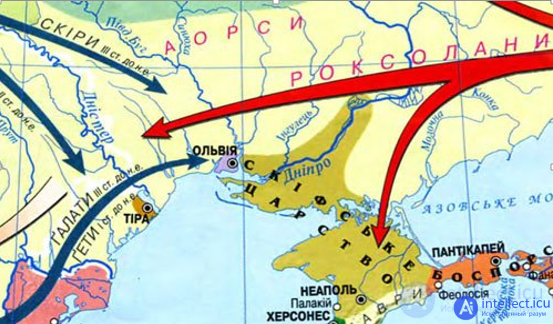
The greatest archaeological finds of our time in the mounds of the royal Scythians
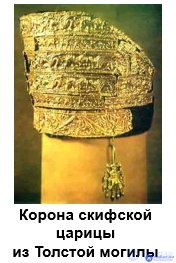
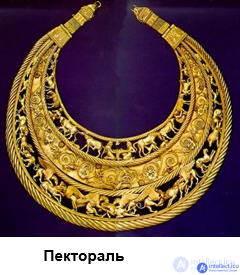
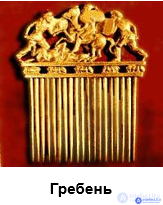
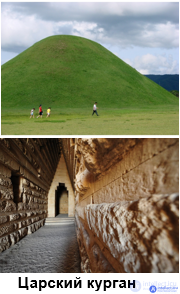
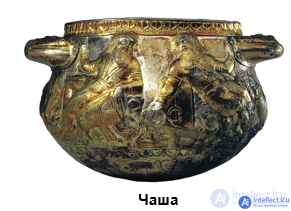
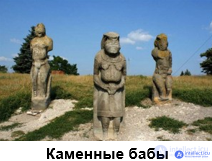
Skifov was superseded by a new group of Iranian-speaking tribes - Sarmatians ("belted with a sword") III B. BC - III V.N.E.
In the II-III centuries. BC, the Sarmatians expelled German tribes who came to the Black Sea steppes from the shores of the Baltic Sea and occupied the territory from the Don to the Carpathians and the Lower Danube. The borders of the state - Sarmatia - stretched in the south-west from the Carpathians, Vistula and Danube to the Don, Volga, Urals in the east.
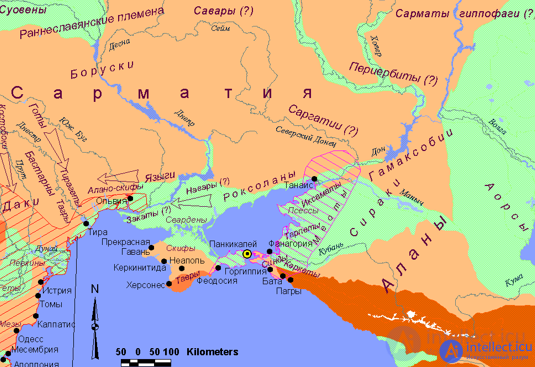
The leader is ready German, famous for songs and legends, uniting not only Gothic tribes, but also conquered neighboring ones, including Finnish and Slavic.
PUBLIC STORY OF SARMATOV:
1. Formation of a slave state (capital of Tanais).
2. The presence of a large number of rights for women - participation in public life, sacred and military operations (the image of the Amazon). Matriarchy was also manifested in the transfer of kinship along the female line.
3. Innovations in equestrian combat technology - instead of horse archers, they began to use long heavy spears and swords (up to 130 cm), which ensured the success of military campaigns.
SARMATIAN LESSONS:
1. nomad cattle breeders;
2. hunting, fishing;
3. part of the tribes engaged in agriculture;
4. Crafts;
5. military robbery.
HISTORICAL DESTINY OF SARMATS:
Destroyed in the III - IV centuries. AD as a result of the invasion of the ready. The Sarmatians, under the name of the small tribe of Alans, advanced to the Balkans, and from there to Spain, where they formed a small kingdom subordinated to the Visigoths several centuries later.
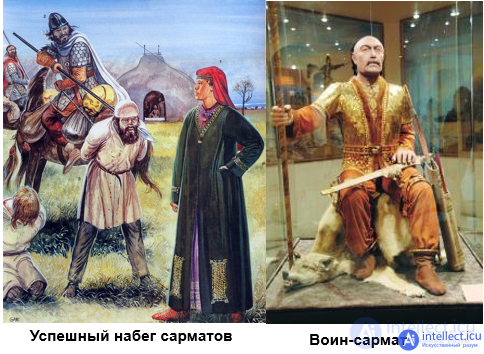
The greatest archaeological finds of our time in the burial mounds of the Sarmatians

Ornaments are richly ornamented, the masters mastered the technique of filigree and grains, working with gold wire. The figures of animals - predators, dragons, ungulates - were depicted in dynamic poses.
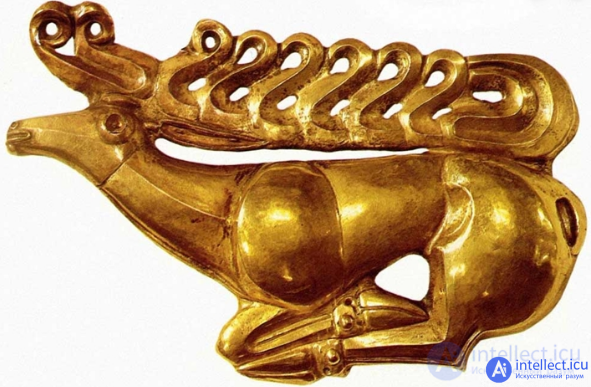
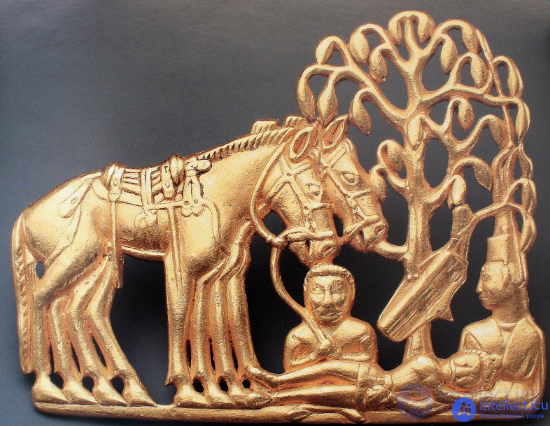
The so-called "Animal Style" in the art of Samatov
In the II — III centuries. AD Sarmatians were supplanted by GERMAN TRIBES READY,
coming from the shores of the Baltic Sea and occupying the territory from the Don to the Carpathians and the Lower Danube. The leader is ready Germanarich united the Gothic, Finnish and Slavic tribes.
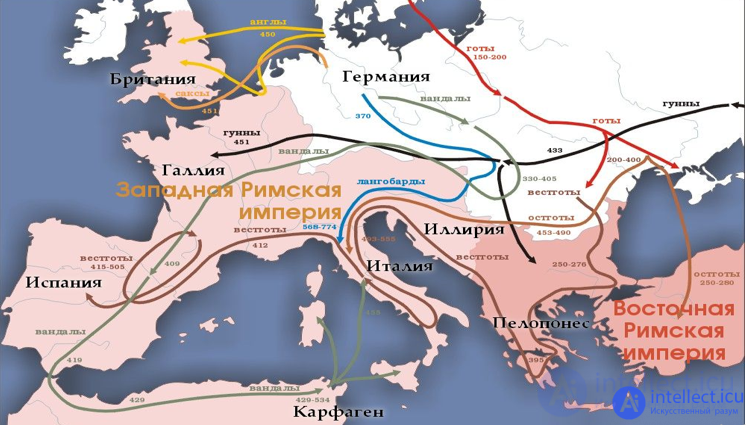
IV-VII centuries. known in history as the Great Relocation
The Huns reached their greatest power under the leadership of the leader Attila (440). From the Black Sea steppes they went west, attacking the Eastern and Western Roman empires.
. The invasion of the Huns 2 (from the 70s of the 4th century) opens a series of successive Asian invasions of Europe. The Huns passed through the southern Siberian steppes and through the "great gates of the peoples" between the Ural Mountains and the Caspian Sea to Eastern Europe. They broke the ready, and their old leader Germanarich, in desperation, committed suicide. Leading a powerful alliance of tribes, the Huns carried out destructive campaigns in many countries. The Huns managed to achieve their greatest power when they were led (in 440) by the fierce leader Attila. They moved from the Black Sea steppes to the west, to the Danube plain, attacking the Eastern and Western Roman empires, and took a ransom from them. After the death of Attila 3 in 453, the Union of Huns disintegrated.
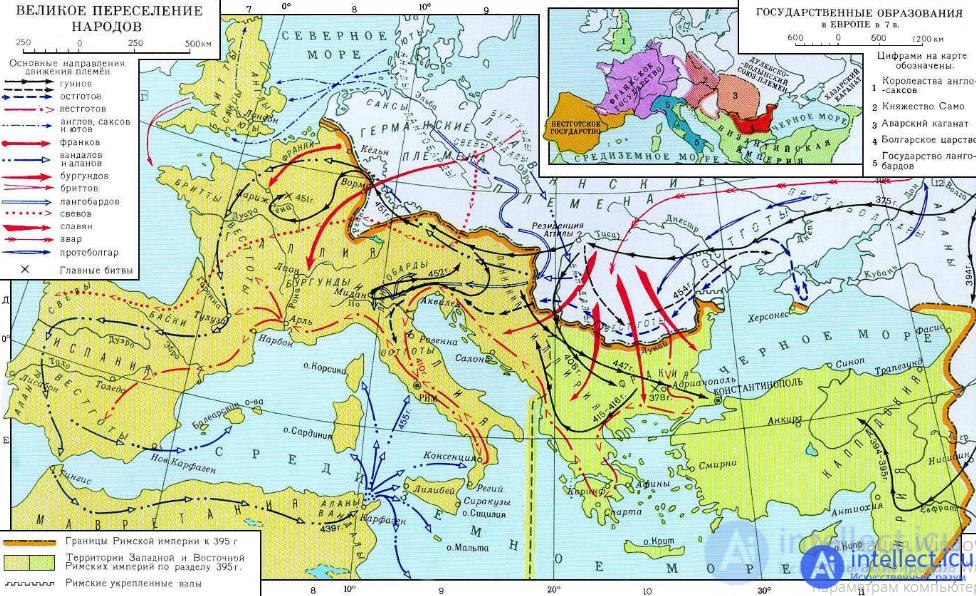
In VI. they were replaced by Avars 1 who lived in the Danube basin, oppressing the conquered tribes, including the Slavs.
In the VII century . a new nomadic tribe appeared, the Khazars, which created a huge state from the Caucasus Mountains to the Volga, and the Sredinno-Dneprovsky - the Khazar Khaganate (VII-X centuries).

All these peoples and tribes not only preceded the emergence of Slavic tribes on the East European plain, but also already coexisted with them and had a mutual influence on each other.

There are several versions of the ancestral home of the Slavs and their ethnogenesis 2, which have been proposed and proposed by various scholars. But they all take as the basis the oldest Russian written monument - the chronicle "The Tale of Bygone Years" 3, attributed to the monk of the Kiev Pechersk Monastery Nestor (beginning of the XII century). Nestor puts forward a mythological version of the origin of the Slavs: as if their race was rooted in the youngest son of Noah-Yaphet, who, after dividing the land with his brothers, received the northern and western countries. Gradually, historical facts appear in the narrative. Nestor settles the Slavs in the Roman province of Norik, located between the upper Danube and Drava. From there, pressed by the Volokhs (implied by the Romans), the Slavs were forced to move to new places on the Vistula and the Dnieper.
The Danube version of the ancestral home of the Slavs was kept by the Russian historian S.M. Soloviev, referring to the Roman historian Tacitus.
Pupil S.M. Soloviev - historian V.O. Klyuchevsky also recognized the "Danube" version of the Slavic homeland. But he made his explanations, but he was before the Eastern Slavs from the Danube entered the Dnieper, they were in the foothills of the Carpathians for about 500 years. According to Klyuchevsky, only from the 7th century did the Eastern Slavs gradually settle on the modern Russian plain.
Some Soviet scientists were inclined to the Danube origin of the Slavs, but most adhered to the version that the homeland of the Slavs was located in the far north. At the same time, they disagreed on the ethnogenesis of the Slavs, and on where the Slavs were formed into a single ethnic community - in the Middle Dnieper and along the Pripyat or between the Vistula and Oder.
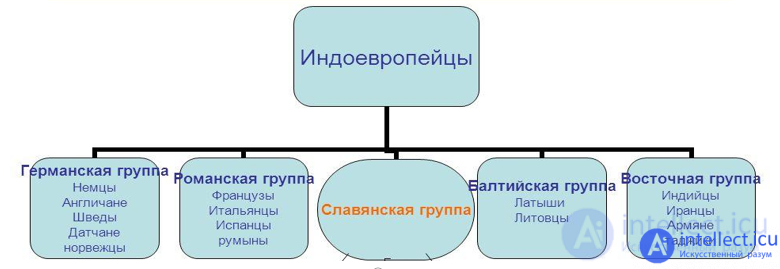
The archaeologist and historian academician Ba fisherman Rybakov, based on the latest archaeological data, tried to combine both of these versions of the possible ancestral homeland of the Slavs and their ethnogenesis. In his opinion, the early Slavs occupied a wide strip of Central and Eastern Europe: from north to south, with a width of about 400 km, and from west to east - about 1.5 thousand km. Its western half from the south was bounded by the European mountains - the Sudetenland, Tatra Mountains, Carpathians, and in the north the lands of the Slavs reached almost the Baltic Sea. The eastern half of the Proto-Slavic land was bounded from the north by the Pripyat River, and from the south by the upper reaches of the Dniester and southern Bug rivers and the basin of the Ros River that flows into the Dnieper.
B.A. Rybakov believes that the Slavs belong to the ancient Indo-European unity, which includes such peoples as German, Iranian, Celtic, Indian, Greek and others. The center of the original Indo-European massif was 4–5 thousand years ago the northeastern part of the Balkan Peninsula and Asia Minor . At the turn of the III and II thousand. Bc. in the northern part of Europe (from the Rhine to the Dnieper) a shepherd’s farm developed, and in search of pasture the shepherd’s tribes settled in Eastern Europe in the second millennium. Settled related Indo-European tribes gradually formed large ethnic massifs. One of such massifs was the glorious people who settled in the territory from the Middle Dnieper in the east to the Oder in the west, from the northern slopes of the Carpathians in the south to the latitude of the Pripyat river in the north.
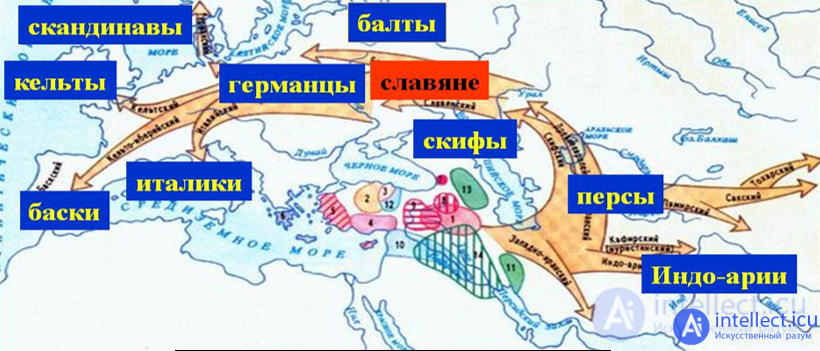
Information about the Slavs (the so-called chips) appears already in the V century. BC. ancient Greek historian Herod A. Other ancient authors - Polybius (3-2 centuries BC), Titus of Libya (1st century BC - 1st century BC), Strabo (1 century AD), Tacitus (c. 58 - p. 117) provide information about the Slavs called Venice (Venetian), who lived among the Scythian and Sarmatian tribes somewhere on Vistula. More detailed information about the Slavs appears in the Byzantine historian Procopius of Caesarea (about 500 after 565) and the Gothic historian of Jordan (Jordan) (VI century).
Procopius of Caesarea highly appreciates the Slavs, especially their ability to fight in mountainous, inaccessible places. He writes about their political system: "These tribes of Slavs and ants are ruled by more than one person, but since ancient times they have become a democracy, and therefore decisions are made together for all happy and unfortunate circumstances."
For the first time, Jordan describes the Slavs under its tribal names Wends, Antesi and Slavs, as originating from the “same root”. According to him, the Vends are the ancestors of the Western Slavs who lived in the northwest to the Vistula and in the southeast to the Dniester. The ancestors of the eastern Slavs - Antes, "the most powerful among the Slavs," according to Jordan, lived in the south along the Black Sea coast, in the lower reaches of the Dnieper and Danube. In general, the Slavs (Slavs) lived in the north, in Ladoga and Priozerye.

By the time the Slavs joined the Great Migration of Peoples (VI century), the countries of the world went a long way of development: huge states arose and collapsed, and active migration processes took place. In IV. the great Roman Empire collapsed. In Europe, with the center in Rome, a Western Roman state was formed. On the territory of the Balkans and Asia Minor, a new powerful state arose - the East, with a center in Constantinople, later called the Byzantine Empire (lasted until 1453). He became the heir and successor of Greek culture, the most powerful and economically developed European state. He had a great influence on his neighbors and the tribes who traded with him, including the Slavs.
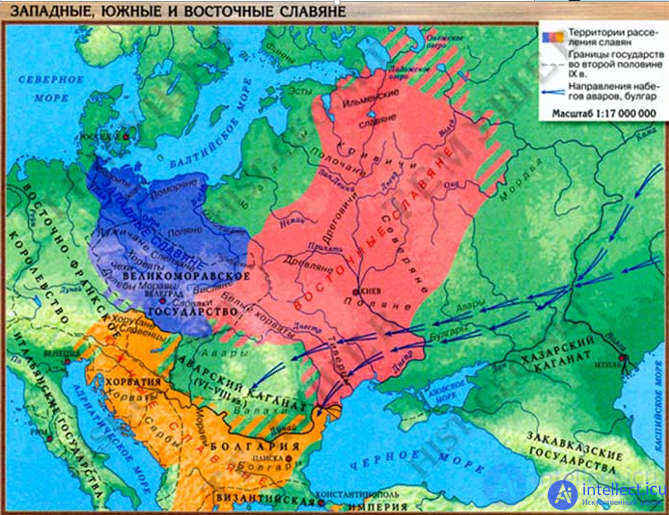
In Western Europe in the V-VII centuries. there was a resettlement of the Germanic tribes who conquered the territory of the Roman Empire. It formed the so-called "barbarian" kingdom - the Frankish, Visigothic, Lombard and others.
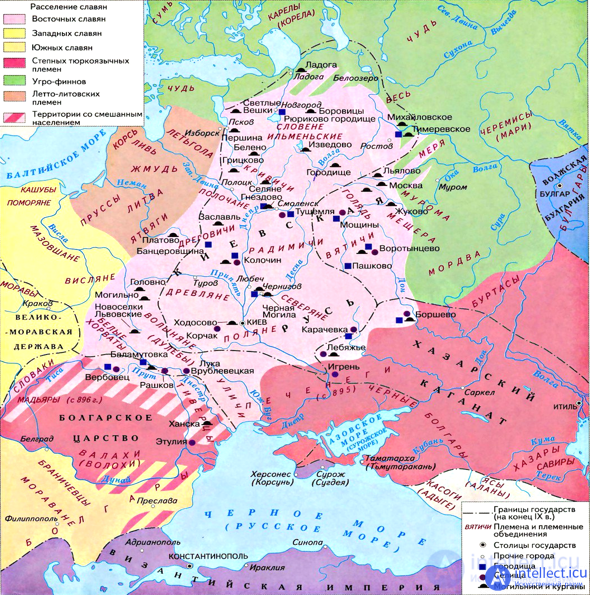
In the VI century. Slavs are involved in the global migration process. The resettlement of the Slavs occurred in the VI-VIII centuries. in three main areas: - in the south on the Balkan Peninsula; in the west - on the Middle Danube and between the Oder and the Elbe; in the east and north - on the East European Plain. At the same time, the Slavs were divided into three branches: southern, western and eastern. The southern Slavs include the current Bulgarians, Serbs, Croats and others, the western - Poles, Czechs, Slovaks, peasants, the eastern - Russians, Ukrainians and Belarusians.
Classes Slavs

Agricultural tribes who spoke Slavic built fortifications along the banks of the rivers. The settlements consisted of small huts (up to 1,000 houses).

A significant place in the economic activity of the Eastern Slavs belonged to hunting and fishing, which was largely favored by natural conditions. The main hunting tools are bow and spear. For hunting birds and small animals, snares and hunting nets were widely used. In ancient Russia (in Kievan Rus) also widespread flight
CRAFT AND TRADE DEVELOPMENT
The development of crafts, livestock farming and jewelry contributed to the emergence of specialized settlements, which later became centers of internal, and in some cases, foreign trade.
2 trade routes passed through the lands of the Slavs:
1.From the Vikings to the Greeks.
2.From the Varangian to the Persians.
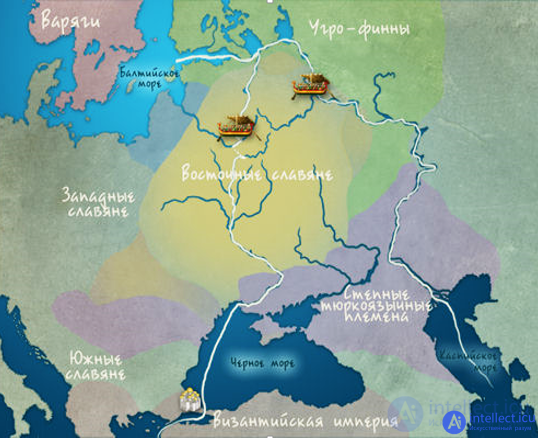
FOUNDATION OF KIEV - THE CAPITAL OF KIEV RUSSIA in 482

The emergence of economic inequality in Slavic society was facilitated by tribal exchange, trade relations with nomadic neighbors, Byzantium and Khazaria, and military clashes. Slavs of the VI century the social category of tribal nobility was known.
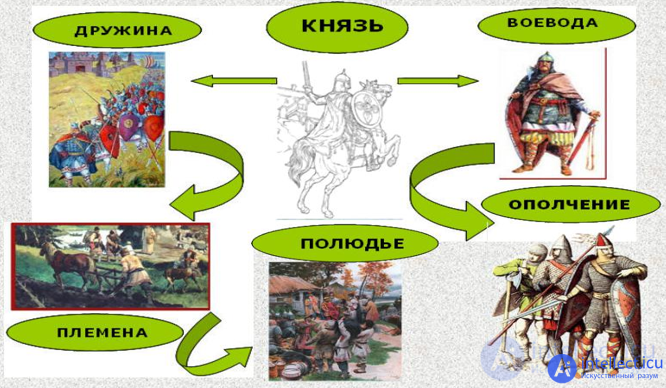
Clothing of the ancient Slavs

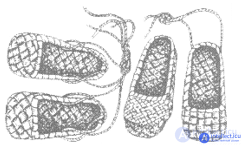
RELIGIOUS BELIEFS OF ANCIENT SLAVS
Stribog, Yarilo, Svarog, Perun, Hair (Veles), Mokosh, Lada
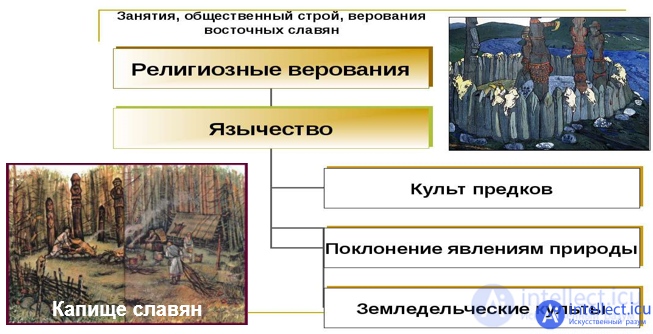


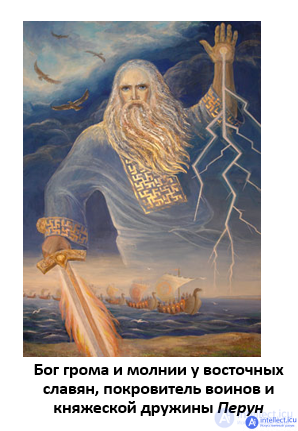
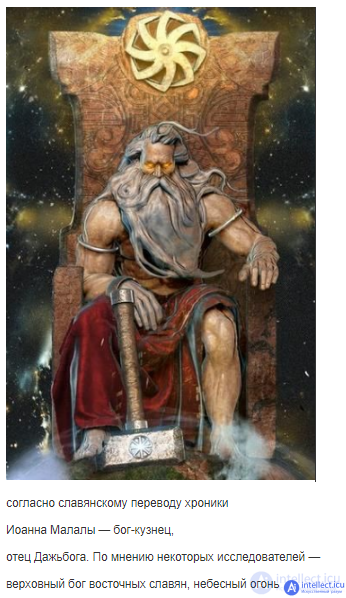

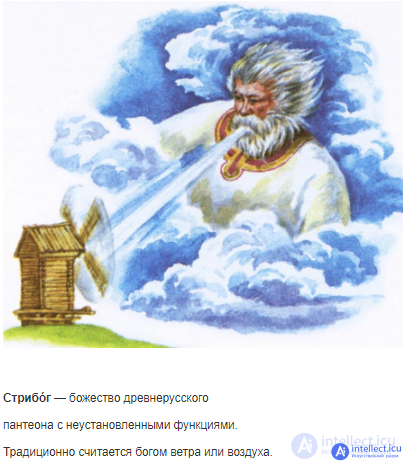

The Adoration of Stribog (engraving from the book of G. A. Schleizing “Ancient and New Religion of the Muscovites”, 1698)
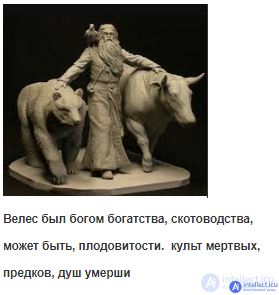
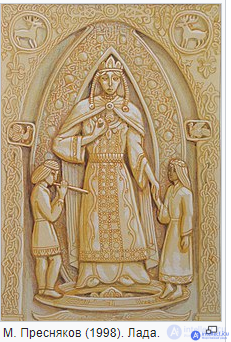
Lada is the goddess of love and marriage, the goddess of world harmony, the patroness of childbirth, women, children, marriage, love, women's affairs, crops, fertility.
At the seventeenth age, Innocent Gizel, in his Synopsis, supplemented to the story “ Become Minute Lit ” about Prince Vladimir’s idols, wrote:
... The fourth idol is Lado. This name of the god of merriment and all prosperity. I bring sacrifices to him who is getting ready for marriage, with the help of Lada, who imagines himself to be good fun and kindly acquiring life. This very same charm from the most ancient idolaters happened, even like some gods Lel and Polel, to venerate, their Bogomery name and until now in some countries on the host of people playing singing Lelum-Polel proclaim. So same mother and Lelev and Polelev - Lado, singing: Lado, Lado! And that idol, the devil’s old charm, is happily married, is splashing his hands and beating at the table, singing
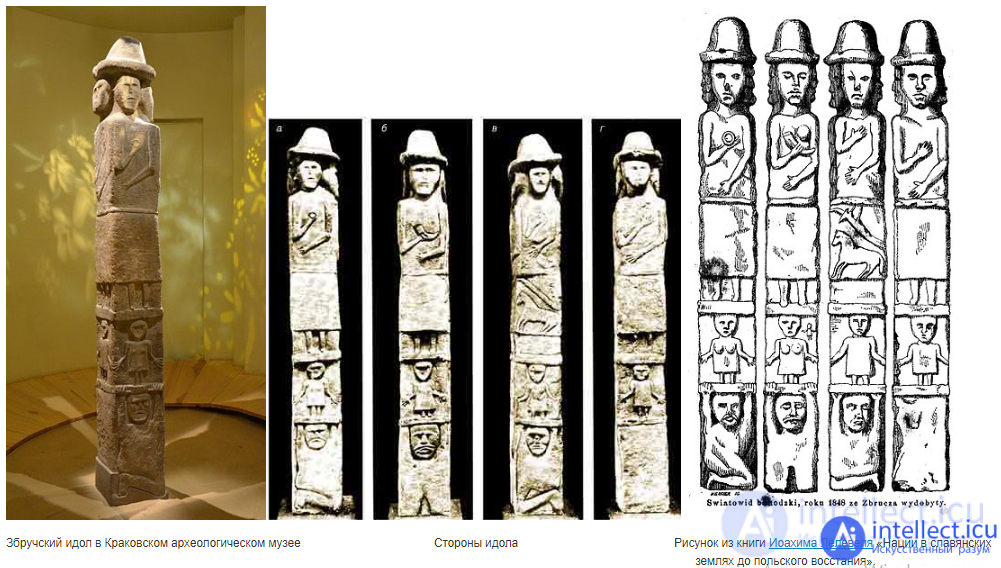
Zbruch idol. OK. X century Stone. Height 2.67 m. - Slavic stone idol found near the village of Gusyatin (now Ternopil region, Ukraine) in the Zbruch river (a tributary of the Dniester) in 1848. The idol is a tetrahedral column 2.67 m high, carved from gray limestone. The column is divided into three tiers, on each of which various images are carved. The lower tier depicts an underground deity, the middle - the world of people, the upper - gods. Idol is crowned with a round hat. Date of creation of the idol - approximately X century

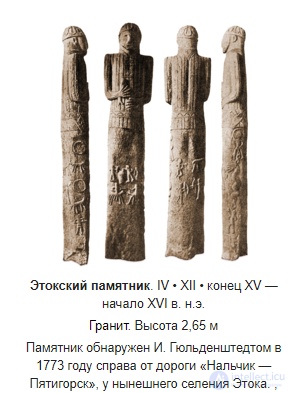
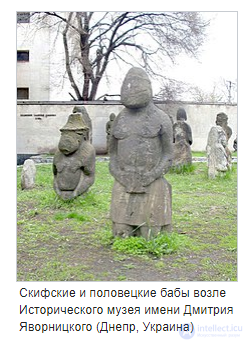
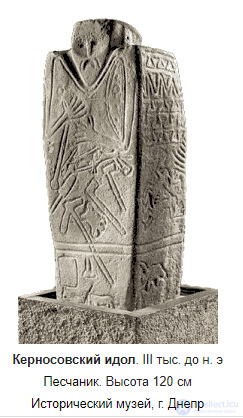

Comments
To leave a comment
The World History
Terms: The World History